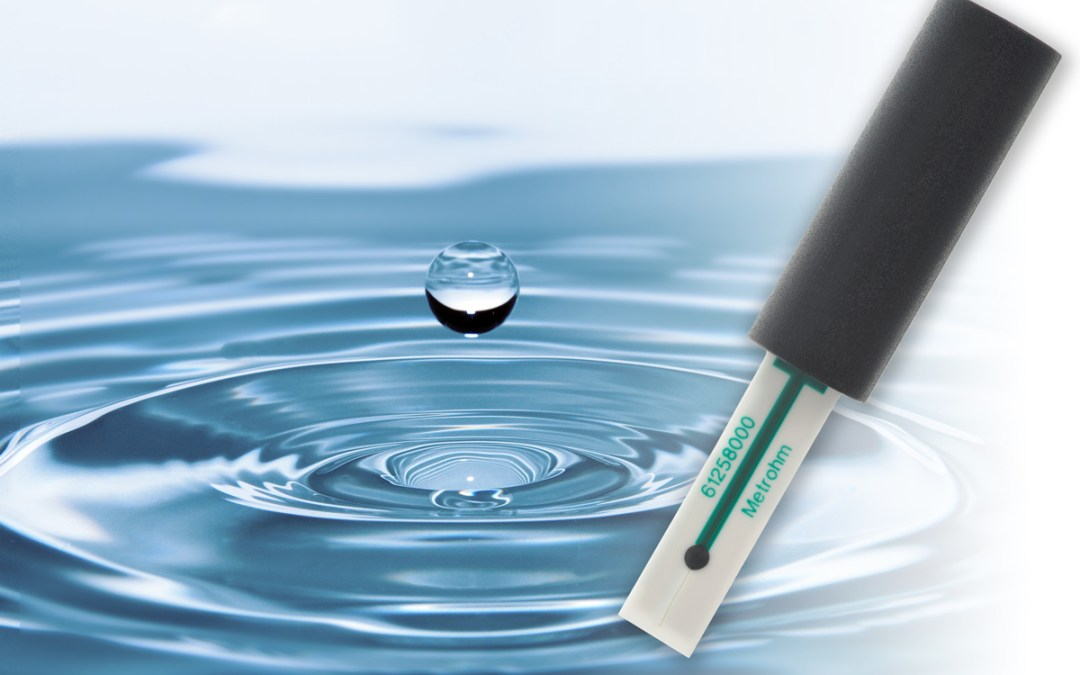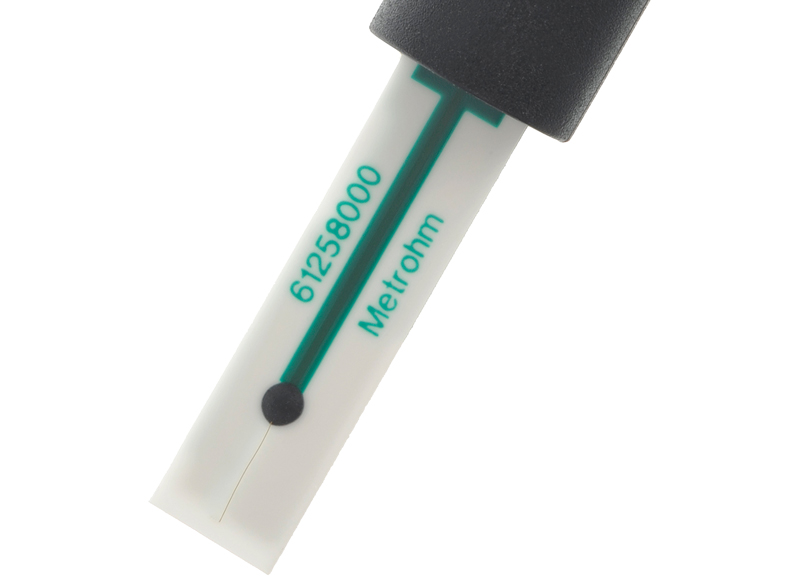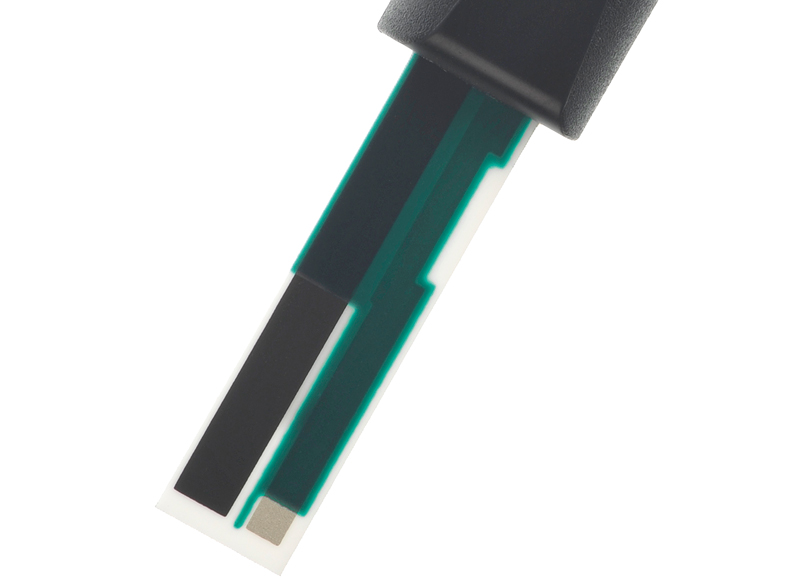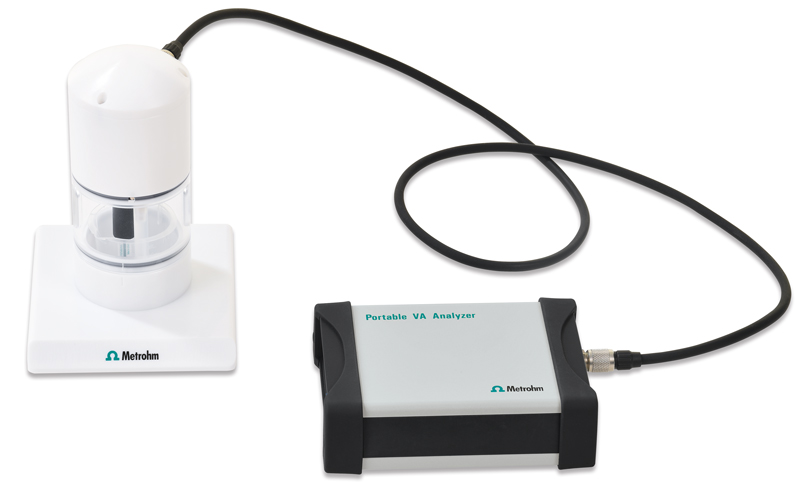This article focuses on the scTRACE Gold electrode, in particular its use in “heavy metal” analysis. Gold electrodes have been utilized in electrochemistry for many years, but the scTRACE Gold makes use of a very special design.

Image Credit: Metrohm AG
While it was initially developed to enhance the voltammetric determination of arsenic, the electrode has demonstrated suitability for the determination of a number of other elements including lead, iron, copper, and even the toxic chromium(VI).
How Does the scTRACE Gold Electrode Work?
The working electrode is comprised of a gold micro-wire (Figure 1), a wire thinner than a human hair. This special type of electrode offers a very short initial preparation time, with the scTRACE Gold being ready for use in a matter of minutes.

Figure 1. Close-up view of the gold micro-wire working electrode on the scTRACE Gold. Image Credit: Metrohm AG
This electrode includes the reference and the auxiliary electrode on the rear side of the sensor (Figure 2). Not only does this save the cost of two additional, necessary electrodes in a voltammetric system, it also removes any need to maintain the reference electrode.

Figure 2. Close-up view of the reference and auxiliary electrode on the rear side of the scTRACE Gold. Image Credit: Metrohm AG
Applications
Voltammetry’s high sensitivity and simple setup make it a valuable tool in drinking water analysis.
Ensuring that clean drinking water is available to all is one of the main concerns of the 21st century. As well as microbiological contaminations (for example, viruses and bacteria), the existence of heavy metals in drinking water can pose a significant health risk.
The provision of clean water requires an accurate identification of contaminants. Health-threatening concentrations of heavy metals are not immediately visible, so limit values of these heavy metals in drinking water are stipulated by authorities like the European Commission and the U.S. Environmental Protection Agency (EPA).
Water quality laboratories often make use of ICP (inductively coupled plasma) to monitor the concentration of metals in drinking water, but voltammetry is one of a handful of analysis techniques offering a comparable level of sensitivity.
Because it requires only basic infrastructure and offers lower running costs, voltammetry is a practical alternative for monitoring some key elements. The following sections outline a series of selected application examples, demonstrating the scTrace Gold electrode’s water analysis capabilities.
Arsenic in Drinking Water
Arsenic gained a degree of global notoriety when water wells were constructed in Bangladesh with a view to avoiding diseases caused by microbiological contaminations in surface water. When the wells were built, however, people became afflicted with chronic arsenic poisoning rather than suffering from cholera or hepatitis.

Image Credit: Metrohm AG
It would be naïve to assume that arsenic is only an issue in less developed countries because arsenic is found almost everywhere in the earth’s crust.
It is the concentration of arsenic that makes it poisonous, so the key issue is around how much of this arsenic can enter the water table. The World Health Organization recommends a maximum concentration of 10 µg/L arsenic in any water intended for human consumption – this is also the legal limit in several countries.
The voltammetric determination of the limit value of 10 µg/L displays a recovery of approximately 92% (n = 10 determinations) with a relative standard deviation of 6.5%. Voltammetry using the scTRACE Gold electrode is capable of a detection limit of 1 µg/L - one-tenth of the legal limit. It offers a cost-effective, reliable means of monitoring the arsenic content of drinking water.
The scTRACE Gold electrode can be used with the 946 Portable VA Analyzer and the 884 Professional VA; the former being intended for mobile use and onsite determination, and the latter being designed for laboratory use.
The system is highly flexible and can be easily adapted to accommodate specific user requirements. The instrument’s modular setup also allows it to be upgraded from manual use to full automation as required.

Image Credit: Metrohm AG
Copper in Surface Water
Copper in drinking water is no cause for concern under normal circumstances. The legal limits are relatively high, and the WHO advises a maximum concentration of 2 mg/L. However, examples from the field reveal instances where the accurate determination of copper in water is prudent.

Image Credit: Metrohm AG
Production of distilled alcoholic beverages such as gin, brandy, whiskey, and schnapps involves single or even multiple distillations of the raw material. This is done in copper stills, and the process of cleaning out these copper apparatus and draining the rinsing water to a river can lead to the environment being contaminated with copper.
Regulatory limits for effluents are generally higher than those for drinking water, but copper limits may still be exceeded if the water is not properly treated before it is discharged. Pollution from these cleaning processes only occurs periodically, making it challenging to detect and even more difficult to confirm, particularly in less accessible areas.
Mobile voltammetry using the scTRACE Gold alongside the 946 Portable VA Analyzer can make a valuable contribution here, helping to protect the environment by effectively determining low concentrations of copper.
For a concentration of 5 µg/L, the mean recovery of 10 determinations is around 107%, with a relative standard deviation of 2%. Concentrations as low as 0.5 µg/L copper can be determined directly at the point of sampling in the water.
Immediate re-sampling can be performed where results may be suspicious, further helping to locate the source of the pollution. Increased chances of identifying the source increase the chance of successfully holding the culprit accountable.
Iron in Drinking Water
According to the World Health Organization, iron poses no health concerns in levels typically found in drinking water. Iron is also an essential element for human nutrition. Regardless of this, a large number of countries stipulate a maximum contaminant level between 200 µg/L and 300 µg/L, because higher concentrations of iron will have an adverse effect on the taste of the water, as well as potentially staining laundry and sanitary appliances.

Image Credit: Metrohm AG
A detection limit of 10 µg/L for the voltammetric determination of iron helps facilitate an easy approach to monitoring iron concentrations in any water supply. Recovery of a voltammetric determination of 20 µg/L Fe is in the range of 91% (n = 10 determinations), with a relative standard deviation of 1%.
Acknowledgments
Produced from materials originally authored by Barbara Zumbrägel from Metrohm.

This information has been sourced, reviewed and adapted from materials provided by Metrohm AG.
For more information on this source, please visit Metrohm AG.